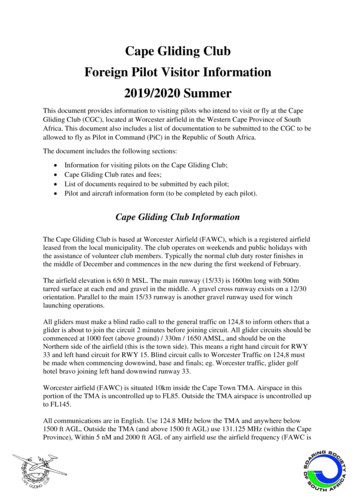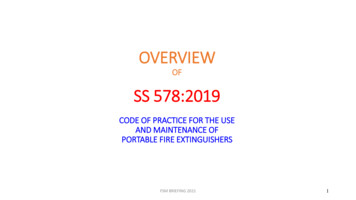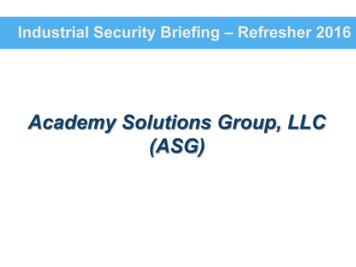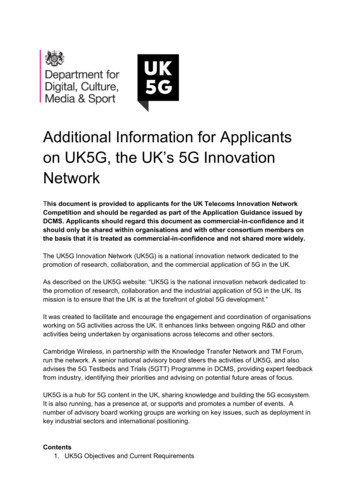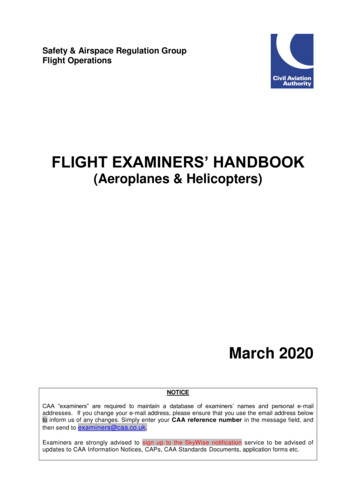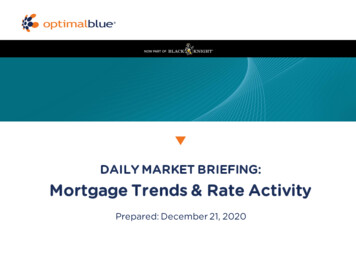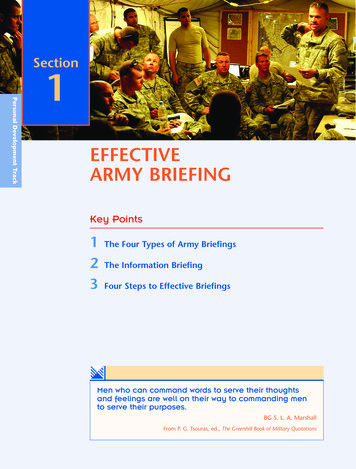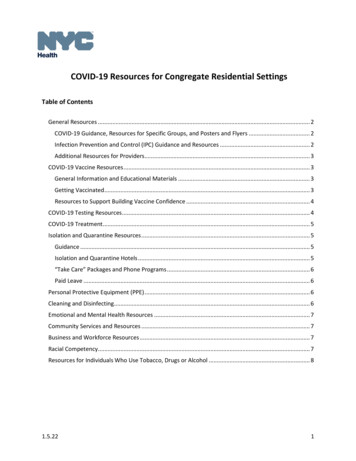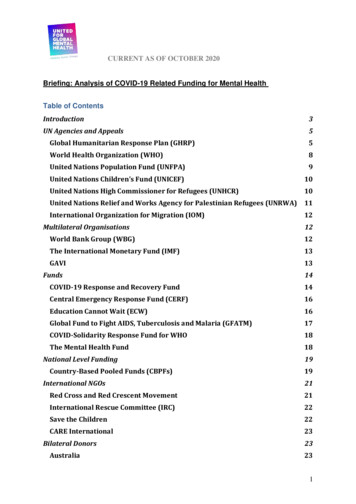
Transcription
CURRENT AS OF OCTOBER 2020Briefing: Analysis of COVID-19 Related Funding for Mental HealthTable of ContentsIntroduction3UN Agencies and Appeals5Global Humanitarian Response Plan (GHRP)5World Health Organization (WHO)8United Nations Population Fund (UNFPA)9United Nations Children’s Fund (UNICEF)10United Nations High Commissioner for Refugees (UNHCR)10United Nations Relief and Works Agency for Palestinian Refugees (UNRWA)11International Organization for Migration (IOM)12Multilateral Organisations12World Bank Group (WBG)12The International Monetary Fund (IMF)13GAVI13Funds14COVID-19 Response and Recovery Fund14Central Emergency Response Fund (CERF)16Education Cannot Wait (ECW)16Global Fund to Fight AIDS, Tuberculosis and Malaria (GFATM)17COVID-Solidarity Response Fund for WHO18The Mental Health Fund18National Level FundingCountry-Based Pooled Funds (CBPFs)International NGOs191921Red Cross and Red Crescent Movement21International Rescue Committee (IRC)22Save the Children22CARE International23Bilateral DonorsAustralia23231
CanadaCURRENT AS OF OCTOBER 202024European Union 1South Korea31Sweden32United Kingdom (UK)33United States (US)34Private Philanthropy35Bill and Melinda Gates Foundation (BMGF)35Lego Foundation36Open Society Foundation (OSF)36Fondation D’harcourt37Google37Wellcome Trust38Stavros Niarchos Foundation (SNF)392
CURRENT AS OF OCTOBER 2020IntroductionSince the outbreak of COVID-19 there has been a global effort - led by the UNsystem, most notably WHO - to address its impact. The international response hasmobilised billions of dollars, and funding has been linked to global plans (such asGlobal Humanitarian Response Plan) and national plans and strategies with a focusprimarily on treatment, vaccine and diagnostics development, health systempreparedness, and financial support to mitigate the wider social and economicimpacts.Below is a summary of global appeals, public commitments and pledges by bilateraldonors, multilateral organisations, NGOs and private donors for the internationalCOVID-19 response in low-and middle-income countries (and in some high-incomecountries when applicable) and with a focus on mental health whenever possible.Not included in this document is a country’s own domestic response.While funding for mental health and psychosocial support (MHPSS) is included insome of the commitments and allocations, the exact extent of this is unclear due to alack of transparency surrounding financing. These issues include:Public information regarding funding the international COVID-19 responsedoes not provide a full, accurate picture of all financial flows The quality of financing data available can be poor, with little to no descriptionof allocations Some announcements may be redirected funds or repeated commitments Some public financial trackers may include a high-income country’s owndomestic response, or exclude economic stimulus efforts related to theoutbreak We will continue to monitor publicly available resources, including the FinancialTracking Service, data from the International Aid Transparency Initiative, UNOCHA’s COVID response website, Relief Web resources, and direct donor sources,to map out how much money has been directed towards MHPSS, and where.Recommended Actions to Support Funding for Mental Health in Relation toCOVID-19As highlighted in the UN policy brief, COVID-19 and the Need for Action on MentalHealth, COVID-19 is not only a physical health crisis, it also has the potential to be amajor mental health crisis, if no action is taken. Despite the major disruption ofMHPSS services globally, the current Global Humanitarian Response Plan (GHRP),highlights that these services are one the least funded aspects of the COVID-19response, and continue to suffer from low investment in human and financialresources, stigma and service disruption. According to our own analysis, moneyspent on MHPSS related activities account for only 0.54% of the GHRP. Strongleadership is required to accelerate funding for MHPSS, and the following is needed:3
CURRENT AS OF OCTOBER 2020International agencies must include mental health as part of theirCOVID-19 response and recovery plans - adopting a multi-sector approachand integrating mental health across relevant sectors including livelihoods,social welfare, child protection and education International development donors must prioritize mental health ensuring it is integrated into COVID19 emergency response and recoveryplanning, with a focus on prevention, promotion, and holistic, life-courseapproaches. They must also improve coordination among themselves toensure efficiency and improve impact National governments should allocate sufficient resources within theirCOVID-19 response and recovery health budgets for mental health - forthose national governments that host refugees, the mental health of thoserefugees must be part of their mental health planning. According to a recentsurvey conducted by WHO, despite 89% of responding countries includingMHPSS as part of their national COVID-19 response plans, only 17% ofthese countries have full additional funding for covering these activities. 4
CURRENT AS OF OCTOBER 2020UN Agencies and AppealsGlobal Humanitarian Response Plan (GHRP)Funding appeal(USD)Purpose of funds and/or mental health inclusion (ifapplicable)10.3 billionA majority of funds to UN entities targeting 63 countries.This July updated GHRP funding requirement is as follows: US 4.9 billion for Humanitarian Response Plans US 999.7 million for other plans US 1.1 billion Regional Refugee Response Plans US 438.8 million for Regional Refugee and MigrantResponse Plans US 1.0 billion for Intersectoral Plans US 1.0 billion Global support services US 500.0 million for Famine prevention US 300.0 million for NGOs - supplementaryenvelopeFunds will be directed to UN Agencies for supportingMHPSS services in varying contexts.The Global Humanitarian Response Plan for COVID19 (GHRP) is the main fundingappeal for the UN agencies collectively, bringing together requirements from theWorld Health Organization (WHO), Food and Agriculture Organization (FAO),International Organization for Migration (IOM), United Nations DevelopmentProgramme (UNDP), United Nations Population Fund (UNFPA), UN-Habitat, UNRefugee Agency (UNHCR), United Nations Children’s Fund (UNICEF) and WorldFood Programme (WFP) and complements other plans such as those developed bythe International Red Cross and Red Crescent Movement.The initial GHRP was launched in March and called for US 2 billion in funding; inearly May the GHRP was updated to a US 6.7 billion appeal and an amended planfor 63 countries, and included an Annex that features progress made by UN agencyand sector needs. In July, the GHRP was updated again to a US 10.3 billionappeal, and updated Annexes. As of early October, it is 31 percent funded.The updated July GHRP (April - December 2020) US 10.3 billion appeal is brokendown as follows: US 1 billion for global support services US 4.9 billion targeting Humanitarian Response Plans countries, US 999.7 million for other plans US 1.1 billion for Regional Refugee Response Plans countries,5
CURRENT AS OF OCTOBER 2020 US 438.8 million for Regional Refugee and Migrant Response Planscountries, US 1.0 billion for Intersectoral Plans US 500.0 million for Famine prevention US 300.0 million for NGOs - supplementary envelopeThe initial GHRP mentions the negative impact on mental health as a result ofCOVID, and the May updated version goes deeper and includes the followingmessages: the impact of COVID on children’s mental health, vulnerable groupsincluding migrants and refugees’ mental health, individuals living with existing mentalhealth conditions, the inclusion of mental health services as essential health servicesthat have been disrupted, increased mental health services for individuals that needalso access to gender-based violence (GBV) services, and the impact of schoolclosure on children's mental health.In July, the updated GHRP advocates for the integration of MHPSS in all sectors toimprove humanitarian programming, acknowledges that MHPSS services areamongst the least funded aspects of the current COVID-19 response, and includesdata on the increase of mental health services in various regions. It also providesupdates on the mental health needs of various affected groups including: olderpersons, children, caregivers/parents, adolescents and youth, refugees, migrants,asylum seekers, and internally displaced persons.The strategic objectives and indicators that include MHPSS, the leading UNagencies responsible for meeting these objectives, and the progress made isrepresented in the following table:ObjectiveObjective 1.6:Ensureessentialhealth servicesand systems:secure thecontinuity oftheessentialhealth servicesand relatedsupply chainfor the directpublic healthresponse tothe pandemicas well asIndicatorNumber of GHRPcountries with multisectoral MHPSStechnical workinggroupsLeadUNAgencyWHOTarget100%Progress46% (29countries)6
CURRENT AS OF OCTOBER 2020other essentialhealthservices.Objective 2.2:Ensure thecontinuity ofand safetyfrom infectionof essentialservicesincludinghealth, waterand sanitation,nutrition,shelterprotection andeducation forthe populationgroups mostexposed andvulnerable tothe pandemic.Number of people(including children,parentsand primarycaregivers)provided with mentalhealth andpsychosocialsupport 8IOM719,674133,921Number andproportionof countries whereGBV services aremaintained orexpanded inresponse to COVID19UNFPAUNHCRTo be updatedwith MHPSSdata in nextGHRP updateto be updatedwith MHPSSdata in nextGHRP updateObjective 3.1:Advocate andensure thatrefugees,migrants,IDPs, peopleof concern andhostpopulationgroups whoare particularlyvulnerable tothe pandemicreceiveNumber of refugees,IDPs, migrants andhost communitiesparticularlyvulnerable to thepandemic whoreceive COVID-19assistance. (COVID19 assistance caninclude MHPSS)IOM8,797,0164,474,039(exact 7 millionpeople22.6 millionpeople19(exact numberforpsychosocial7
CURRENT AS OF OCTOBER 2020COVID-19assistancesupportservicesunknown)In October, funding for interventions that included MHPSS accounted for only 0.54%of all financial flows to the GHRP. At the time of analysis, donors had given US 2.98billion in total to the GHRP, out of which US 16.1 million was allocated to activitiesthat included MHPSS. Sources of these funds included ECHO, country-basedpooled funds, Germany, Switzerland, UNICEF, Sweden and Switzerland. The detailsof these flows are included in the specific donor information provided further thisdocument.MHPSS allocations in the UN GHRP(October 2020) 16,100,5300.54% 2,963,146,541MHPSSNon-MHPSSFinancial allocations to activities that included MHPSS were determined by UGMH's own analysis, using FTSdata downloaded on 6 October 2020.World Health Organization (WHO)Funding appeal(USD)Purpose of funds and/or mental health inclusion (ifapplicable)1.7 billion (550 million Funding appeal is for:from the GHRP) Improving country preparedness and response Accelerating research and development Coordinating across regions to access, respond andmitigate risks 550 million in the GHRP to support thehumanitarian component of national preparednessand response plans to respond to the healthemergency.8
CURRENT AS OF OCTOBER 2020The WHO’s Strategic Preparedness and Response Plan (SPRP) was initiallyreleased in February 2020 and called for US 675 million for response efforts tillApril. On 14 April, this plan was updated and includes the importance of supportsystems in suppressing community transmissions measures, including mental healthsupport. With the updated needs highlighted in the GHRP in July 2020, WHO’s totalCOVID response appeal is now 1.7 billion.The WHO co-chairs (along with the International Federation of Red Cross and RedCrescent Societies) the IASC Mental Health and Psychosocial Support inEmergency Settings Reference Group to support mainstreaming of MHPSS acrossall sectors and clusters in the global response. As highlighted in the GHRP Annex,the WHO will support the integration of mental health and psychosocial componentsas part of essential health packages for all affected populations especially for peoplewith mental, neurological and substance use conditions. Further examples of supportinclude in Turkey, where WHO supported the development of a telephone helplinefor those with mental health issues.United Nations Population Fund (UNFPA)Funding appeal(USD)Purpose of funds and/or mental health inclusion (ifapplicable)370 million ( 270million included aspart of the GHRP.)To provide an integrated response to GBV services,including MHPSS services.Complementary to WHO COVID-19 Strategic Preparedness and Response Plan, theUNFPA COVID-19 Global Response Plan aims to ensure UNFPA continues toprovide an integrated response to gender-based violence (GBV) that includesMHPSS. Originally, UNFPA called for US 187.5 million. In June, this plan wasupdated to 370 million.As highlighted in the GHRP Annex, UNFPA is also training health and social workersto provide MHPSS, and supporting toll-free hotlines and offering services forMHPSS.9
CURRENT AS OF OCTOBER 2020United Nations Children’s Fund (UNICEF)Funding appealtarget(USD)Purpose of funds and/or mental health inclusion (ifapplicable)1.6 billion (802.2million is forUNICEF’s input toGHRP)Strategic Priorities: Public health response to reduce coronavirustransmission and mortality Continuity of health, HIV, nutrition, education,WASH, child protection, gender-based violence,social protection and other social services;assessing and responding to the immediate socioeconomic impacts of the COVID-19 responseo Supporting access to continuous education,social protection, child protection, MHPSSand gender-based violence servicesUNICEF’s appeal calls for US 1.6 billion with US 802.2 million for the UNICEF inputinto the GHRP. This appeal is in line with the GHRP, and WHO’s COVID-19Strategic Preparedness and Response Plan. Mental health is included in strategicpriority #2: Continuity of health, HIV, nutrition, education, WASH, child protection,gender-based violence, social protection and other social services; assessing andresponding to the immediate socio-economic impacts of the COVID-19 response.Specifically, UNICEF will strengthen and/or establish response and referralmechanisms for GBV and MHPSS services and build the capacities of frontlineworkers on the provision of psychological first aid. This is also highlighted in theGHRP Annex, where it is noted that UNICEF and UNFPA are working together toprovide remote GBV services, including psychosocial support.As highlighted in the latest GHRP, UNICEF has assisted with providing more than9.5 million people (including children, parents and primary caregivers) with MHPSSservices. Further specific examples include UNICEF assisting with the provision ofpsychosocial support and first aid for children, adolescents and caregivers inAfghanistan, and funding psychosocial support interventions alongside legalrepresentation for children in Iraq.United Nations High Commissioner for Refugees (UNHCR)Funding appeal(USD)Purpose of funds and/or mental health inclusion (ifapplicable)745 million till the end For activities in health and WASH, protection and riskof 2021communication, cash assistance, shelter and core reliefitems and education. MHPSS inclusion:10
CURRENT AS OF OCTOBER 2020 strengthen mental health and psychosocialresponses to increased anxiety, distress andconsequences of loss associated with thispandemic. enhance critical case management, includingassistance to survivors of GBV, unaccompaniedand/or separated children, and other emergencyprotection cases, through the provision of MHPSSand/or legal advice integrate MHPSS in health and protection activities.UNHCR’s appeal has called for US 745 million until the end of the year. MHPSS isan integral component of UNHCR’s response priorities, in health and protectionclusters. UNHCR will integrate MHPSS within its health and protection activities,including through community messaging about coping with distress, capacity buildingof MHPSS community-based staff, training first responders in psychological first aid,and ensuring care for and protection of people of concern with severe protectionrisks and mental health conditions through remote and direct support. UNHCR willalso mitigate protection risks posed by school closures through expanded supportservices such as school feeding schemes, continuity of learning and MHPSSprogrammes at home where possible.United Nations Relief and Works Agency for Palestinian Refugees (UNRWA)Funding appeal(USD)Purpose of funds and/or mental health inclusion (ifapplicable)93.4 millionTo provide lifesaving services to Palestine refugeesthroughout the Middle East. MHPSS is included in theprotection response. UNRWA will ensure MHPSS isdelivered remotely.UNRWA’s updated appeal seeks US 93.4 million for March till July in the areas ofhealth care, sanitation and hygiene and education. MHPSS is a part of the protectionresponse, to be maintained remotely. To support the mental health and psychosocialwell-being of school-aged children, UNRWA will also support the design anddistribution of educational games to students between the first and fourth grades.UNRWA’s remote MHPSS activities are also highlighted in the GHRP Annex.11
CURRENT AS OF OCTOBER 2020International Organization for Migration (IOM)Funding appeal(USD)Purpose of funds and/or mental health inclusion (ifapplicable)499 MillionTo support vital preparedness, response and recoveryactivities in over 140 countries. This includes creatingMHPSS self-help tools specifically tailored for strandedmigrant populations in quarantine, as well as deployingpsychosocial mobile teams linguistically and culturallycapable of serving vulnerablepopulations, including displaced persons.IOM’s Global Strategic Preparedness and Response Plan (SPRP) calls for US 499million and targets 140 countries. It is in line with WHO’s COVID-19 GlobalPreparedness and Response Plan and GHRP.As highlighted in the GHRP Annex, IOM is supporting government efforts to ensureessential health services are available to migrants and IDPs, including MHPSSservices. Other activities highlighted in the SPRP include: organizing remote trainingsessions related to MHPSS in reception centres in the province of Rome, andadvocating the government of Tunisia to provide essential services to migrants(including MHPSS)Multilateral OrganisationsWorld Bank Group (WBG)Funds allocated(USD)Purpose of funds and/or mental health inclusion (ifapplicable)160 billionUS 160 billion available over the next 15 months throughfinancing tailored to the health, economic and socialshocks. Included in this: US 14 billion fast-track facility to respond toimmediate health and business needs in 25countries. This can include support to MHPSSservices, in the case of India.The WBG plans to deploy US 160 billion in funds over the next 15 months to assistcountries' responses. Included in this is a US 14 billion fast-track facility (FTF) thatwill respond to immediate health and business needs. The first round of projectsfunded by the FTF covered 25 countries and amounted to US 1.9 billion. Includedin this, India received US 350 million in funding from the FTF (a total of US 1 billion12
CURRENT AS OF OCTOBER 2020in total with other funds provided by IBRD) to strengthen health systems, includingsupport for mental health and psychological services for vulnerable communities.A full list of projects supported by FTF can be found here.The World Bank has also established a new Trust Fund: Health EmergencyPreparedness and Response Multi-Donor Fund (HEPRF), to provide incentives forlow-income countries to increase investments in health preparedness and supportthe immediate COVID-19 response. This fund will complement and be in addition tothe US 160 billion.The International Monetary Fund (IMF)Funds allocated(USD)Purpose of funds and/or mental health inclusion (ifapplicable)100 billionFunds have been available through rapid disturbingemergency financing activities for low income countries.The Catastrophe Containment and Relief Trust has beenreplenished to provide grants for debt relief.The IMF has made available US 100 billion through rapid disbursing emergencyfinancing facilities. The Catastrophe Containment and Relief Trust (CCRT), whichwas initially set up during the Ebola outbreak, has been replenished, and allows theIMF to provide grants for debt service relief. At the Spring Meetings the IMF andWorld Bank announced debt relief for 25 LMICs in relation to COVID-19. The IMF isnow working with donors to almost triple the CCRT from 500 million to 1.4 billionto extend the duration of relief.GAVIFunds allocated(USD)Purpose of funds and/or mental health inclusion (ifapplicable)200 million allocatedproviding immediate funding to health systems, enablingcountries to protect health care workers, perform vitalsurveillance and training, and purchase diagnostic tests inlower-income countries.GAVI has made US 200 million available to assist lower-income countries’response and strengthen health systems. As of 7 May, US 29 million has beenapproved for 13 countries to supply personal protective equipment (PPE), performvital surveillance and training, and fund diagnostic tests. Situational reports areupdated on GAVI’s website, to track the response.GAVI received more than 8.8 billion during the June replenishment conference.13
CURRENT AS OF OCTOBER 2020FundsCOVID-19 Response and Recovery FundFunding target andallocations(USD)Purpose of funds and/or mental health inclusion (ifapplicable)2 billion targetThree funding windows: Tackle the health emergency Reduce social impact and promote economicresponse Strengthening national preparedness measures.There is the possibility of inclusion of MHPSS services inthe funding windows.1 million allocatedTo strengthen national preparedness, response andresilience in Cambodia. The programme will also provideMHPSS to parents, other caregivers, and children as wellas to frontline health and social service workers.Recipients: UNICEF, IOM, WHO, UNFPA401,645 allocatedSupporting the development of coping mechanisms,including the University of Pristina’s psychoeducationalwebsite. Recipients: UNICEF, UN Volunteers300,000 allocatedTo support the capacity of the mental health system in theMaldivesRecipients: WHO, UNICEF120,000 allocatedFor education continuity in Bhutan. This includessupporting school counsellors to provide online and mobilepsycho-social supportRecipients: UNICEF1,000,000 allocatedFor continuity of basic health services in Gambia, includingpsychosocial services.Recipients: UNICEF, UNOPS, UNFPA300,670 allocatedFor supporting health preparedness in Lao, including theprovision of psychosocial support in quarantine centresRecipients: IOM, UNDP, UNODC, UNHABITAT1,000,000 allocatedFor mitigating the social and economic impacts in Armenia.This includes providing psychosocial support via a helplineand virtual platform.Recipients: IOM, UNFPA, UNDP, UNICEF400,000 allocatedFor supporting vulnerable groups in Côte D’Ivoire. Thisincludes providing psychosocial support.14
CURRENT AS OF OCTOBER 2020Recipients: UNICEF, UNHCR, UNODC, UNFPA1,000,000 allocatedFor the Georgian government’s response, includingproviding psychosocial support to the elderly.Recipients: UNICEF, UNFPA, UNDP1,000,000 allocatedTo support the Guatemalan HRP, this includes providinghumanitarian assistance and psychosocial support toreturned migrants.Recipients: PAHO, UNFPA, UNICEF, IOM1,000,000 allocatedTo support the education system in Nicaragua, includingPsycho-emotional care for children and the educationalcommunityRecipients: UNICEF, WFP1,000,000 allocatedTo support the Government of Tunisia’s response forvulnerable communities. This includes providingpsychosocial support.Recipients: UNDP, UNHABITAT, UNWOMEN, WFPThe UN has established a Multi-Partner Trust Fund: the UN COVID19 Responseand Recovery Fund to support both the UN GHRP and the WHO StrategicPreparedness and Response Plan. The Fund’s financial requirements are projectedat US 2 billion, with US 1 billion in the first nine months of operation, noting thatthese requirements will be reviewed with the evolution of needs as a result of thepandemic.Three funding windows have been established:1. Enable Governments and Communities to suppress the transmission ofthe virus. This includes supporting countries to fully implement their NationalPlans for Combating COVID-19, and assisting non-health ministries andgovernment agencies to provide critical services interrupted by COVID-19.2. Mitigate the Socioeconomic Impact and safeguard people and theirlivelihoods. This includes enhancing social protection mechanisms, meetingchildren’s food and educational needs and promoting digital innovations.3. Recover Better: this includes strengthening and testing nationalpreparedness, investing in effective and innovative delivery of public servicesto achieve sustainable and inclusive economies.The fund covers all low- and middle- income programme countries and, in particular,those populations not included in the Global Humanitarian Appeal. UN CountryTeams can use the fund to leverage to support national governments andcommunities in meeting priorities and defining programming responses that assuretheir recovery and reach the poor and the vulnerable. The funding windows alsoprovide opportunities for the inclusion of MHPSS by UN organisations. Governmententities and civil society organizations can only access the Fund as implementingpartners of Recipient UN Organizations.15
CURRENT AS OF OCTOBER 2020So far, more than US 8 million from the fund has supported projects that haveMHPSS elements, including strengthening the mental health system in the Maldives,providing MHPSS services in Cambodia, and supporting digital mental healthcontent in Kosovo.Central Emergency Response Fund (CERF)Funds allocated(USD)Purpose of funds and/or mental health inclusion (ifapplicable)134 million (as of 1October)To UN agencies for the COVID-19 response. Examplesinclude: 3.2 million allocated to UNFPA, for the provision ofPSS in GBV services 25 million to IOM to support NGOs provideessential health services (including MHPSS) inBangladesh, the Central African Republic, Haiti,Libya, South Sudan and SudanAs of October, the CERF has released US 134 million. CERF allocations will go tothe WFP to ensure the continuity of supply chains and transport of aid workers andrelief goods; WHO to contain the spread of the pandemic; and other agencies toprovide humanitarian assistance and protection to those most affected by thepandemic, including women and girls, refugees and internally displaced people.Support will also include efforts around food security, physical and mental health,water and sanitation, nutrition and protection.As of 23 June, CERF funds have been allocated to UNFPA, to provide health careand protection assistance, including psychosocial support, in response to GBV in 8countries: Afghanistan, Burkina Faso, Chad, Haiti, the occupied Palestinian territory,South Sudan, Sudan and Venezuela. US 25 million of CERF funds have beenallocated to IOM, to be disbursed to frontline NGOs providing essential healthservices (including MHPSS) in Bangladesh, the Central African Republic, Haiti,Libya, South Sudan and Sudan.Education Cannot Wait (ECW)Funding appealsand allocations(USD)Purpose of funds and/ or mental health inclusion (ifapplicable)50 million appealECW’s 50 million appeal calls for 50 million to covereducation needs for three months.24.5 milliondisbursedBy May, US 24.5 million had been disbursed in emergencygrants for 27 countries. Funds have gone to promote16
CURRENT AS OF OCTOBER 2020psychosocial support as an essential component toeducation, and for training teachers in promotingpsychosocial well-being.19 million disbursedIn July, this new funding will be delivered in partnershipwith national governments, UN agencies and civil societyorganizations in Bangladesh, Democratic Republic ofCongo, Ethiopia, Iraq, Kenya, Lebanon, Libya, SouthSudan, Tanzania and Zambia. See the full list of grantees.13 million disbursedIn July, to scale up the education in emergency responsein the Sahel countries of Burkina Faso, Mali and Niger.Established during the World Humanitarian Summit in 2016, ECW is a platformdedicated to making education a priority in the humanitarian agenda by using pooledfunds from state and non-state actors. ECW is calling for an initial US 50 million tobe allocated for the COVID-19 education response in the next three months.In early April, ECW announced US 23 million in emergency grants for 26 countriesand emergency contexts. Emergency grants for COVID-19 response have beenallocated to 55 grantees, ranging from UN Agencies and NGOs. Activities that havebeen supported include transforming the educational curriculum during the COVIDresponse, which includes psychosocial support, and providing parents and teacherswith tools to provide guidance on promoting psychosocial well-being of children andyouth while away from traditional classroom settings.By the end of July, US 19 million and US 13 million in disbursements wereannounced, all targeting the educational response. During the UNGA75 high-levelvirtual event in September, ECW announced that it had disbursed over 60 million inemergency grants in 35 crisis-affected countries since the start of the COVID-19pandemic.Global Fund to Fight AIDS, Tuberculosis and Malaria (GFATM)Funds allocated(USD)Purpose of funds and/or mental health inclusion (ifapplicable)1 billion in grantflexibility and theCOVID-19 ResponseMechanism.
International agencies must include mental health as part of their . and response plans to respond to the health emergency. 16,100,530 0.54% 2,963,146,541 . The WHO co-chairs (along with the International Federation of Red Cross and Red Crescent Societies) the IASC Mental Health and Psychosocial Support in .
